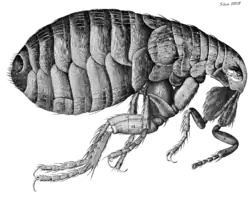Operation Big Itch
Operation Big Itch was a U.S. entomological warfare field test using uninfected fleas to determine their coverage and survivability as a vector for biological agents.[1] The tests were conducted at Dugway Proving Ground in 1954.

Operation
Operation Big Itch was a September 1954 series of tests at Dugway Proving Ground in Utah.[2][3] The tests were designed to determine coverage patterns and survivability of the tropical rat flea (Xenopsylla cheopis) for use in biological warfare as disease vector.[3] The fleas used in these trials were not infected by any biological agent.[4] The fleas were loaded into two types of munitions and dropped from the air.[4] The E14 bomb and E23 bomb, which could be clustered into the E86 cluster bomb and E77 bomb, respectively.[3] When the cluster bombs reached 2,000 or 1,000 feet (600 or 300 m) the bomblets would drop via parachute, disseminating their vector.[3]
The E14 was designed to hold 100,000 fleas and the E23 was designed to hold 200,000 fleas but the E23 failed in over half of the preliminary Big Itch tests.[3] E23s malfunctioned during testing and the fleas were released into the aircraft where they bit the pilot, bombardier and an observer.[4] As a result, the remaining Big Itch tests were conducted using only the smaller capacity E14.[3] Guinea pigs were used as test subjects and placed around a 660-yard (600 m) circular grid.[3]
Results
Big Itch proved successful,[3][5] the tests showed that not only could the fleas survive the drop from an airplane but they also soon attached themselves to hosts.[6] The weapon proved able to cover a battalion-sized target area and disrupt operations for up to one day.[3] The one-day limit was due to the activity of the fleas; the air dropped fleas were only active for about 24 hours.[2]
Notes
- Bubonic plague is an infection of the lymphatic system, usually resulting from the bite of an infected flea.
- Rose, William H. "An Evaluation of Entomological Warfare as a Potential Danger to the United States and European NATO Nations", U.S. Army Test and Evaluation Command, Dugway Proving Ground, March 1981, via thesmokinggun.com, accessed December 25, 2008.
- Kirby, Reid. "Using the flea as weapon", (Web version via findarticles.com), Army Chemical Review, July 2005, accessed December 23, 2008.
- Croddy, Eric and Wirtz, James J. Weapons of Mass Destruction: An Encyclopedia of Worldwide Policy, Technology, and History, (Google Books), ABC-CLIO, 2005, p. 304, (ISBN 1-85109-490-3).
- Novick, Lloyd and Marr, John S. Public Health Issues Disaster Preparedness, (Google Books), Jones & Bartlett Publishers, 2001, p. 89, (ISBN 0-7637-2500-5).
- Leeson, Kate. "Biological Weapons: Bioterrorism and the Public Health", Medical Association for the Prevention of War, 2000, p. 12, accessed December 25, 2008.